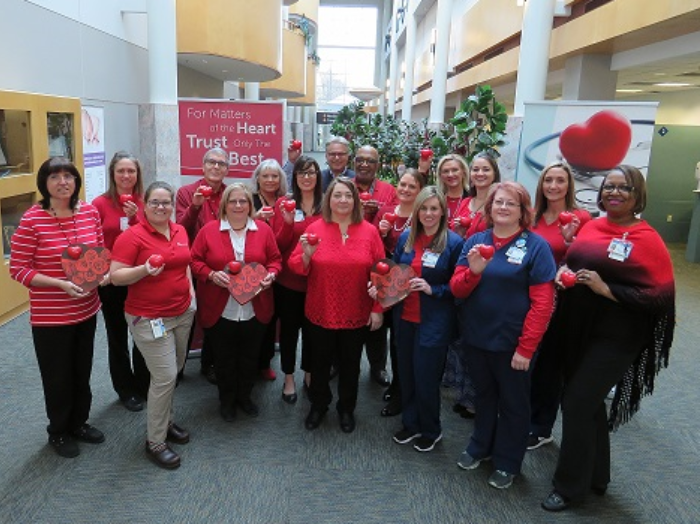St. Luke's Health joins CommonSpirit.org soon! Enjoy a seamless, patient-centered digital experience. Learn more

Each year, the employees at CHI St. Luke’s Health-Memorial participate in the Go Red for Women movement, helping raise awareness about this devastating disease.
Most Americans can describe the classic signs of a heart attack – a tight ache or pressure in your chest, shortness of breath, left arm pain. However, there are a variety of complications that come under the umbrella of cardiovascular disease – arrhythmia, peripheral artery disease, arterial fibrillation, cardiac aneurysms and heart valve issues – just to name a few. With hearts being the primary theme during the month of February – both paper and real – St. Luke’s Health-Memorial wants East Texans to educate themselves about how to prevent all types of cardiovascular disease.
The heart has two systems – “plumbing” and electrical – and both can be affected by cardiovascular disease. Just like the plumbing in a house, plaque buildup can narrow the arteries in the heart, making it more difficult for blood to flow properly. If a blood clot forms, it can stop blood flow causing a heart attack or a stroke. The electrical system in the heart controls the timing of your heartbeat by regulating your heart rate, which is the number of times your heart beats per minute, and heart rhythm, which is the synchronized pumping action of your four heart chambers. Irregular heart rates and rhythms can also have serious consequences.
Women are at a particularly high risk. Each year, cardiovascular diseases claim the lives of nearly half a million women—almost one per minute In fact, more than 8 million women are currently living with heart disease, and last year alone, 267,000 women died from heart disease, according to the American Heart Association. Unfortunately, the signs and symptoms of cardiac distress present themselves in women much differently than men, who often experience the more classic signs, such as chest and left arm pain.
“Although men and women can experience pain as pressure that feels like an elephant sitting on their chest, women can experience a heart attack without chest pain,” said Ravinder Bachireddy, F.A.C.C., interventional cardiologist and President of the Heart Institute of East Texas. “Women may experience shortness of breath, pressure or pain in the lower chest or upper abdomen, dizziness and fainting, upper back pressure, extreme fatigue, or profuse sweating. Even when symptoms are subtle, the consequences can be deadly, especially if women experiencing these symptoms do not get help right away.”
If these signs are present, call 9-1-1 immediately. Seeking medical attention from a high quality health care facility is also essential. St. Luke’s Health-Memorial Lufkin was recently recognized by the American College of Cardiology as a HeartCARE Center National Distinction of Excellence for its comprehensive heart care program, including its accredited Chest Pain and Cardiac Rehabilitation Center, along with the advancement and quality focus in the Cardiac Cath Lab, Electrophysiology Lab and Heart Failure program. There are dozens of standards that must be met in order to achieve the HeartCARE designation. Examples include improving re-admission and mortality rates, tracking the time it takes for a patient to receive certain tests or medications and how long it takes for a patient to be prepped for any necessary interventional procedures or cardiovascular surgery.
While family history dictates what diseases a person is predisposed to there are simple precautions that can be taken to reduce risk factors for heart disease. Eat a balanced low cholesterol diet, exercise regularly, manage stress appropriately, control your diabetes, blood pressure and cholesterol with medications, if necessary, and quit smoking. Preventive measures also include regular follow-ups with a primary care physician to monitor any problems or changes that could require further testing.
Publish date:
Tuesday, February 26, 2019Looking for a doctor? Perform a quick search by name or browse by specialty.